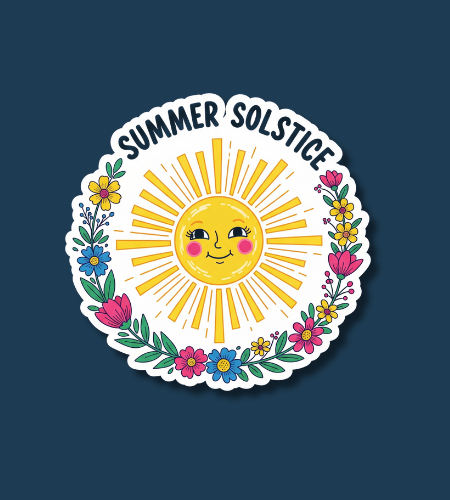Every year, the Summer Solstice occurs around June 20 or 21, marking the longest day of the year in the Northern Hemisphere, when the sun reaches its highest point in the sky, resulting in the maximum daylight hours of the year. This astronomical event signifies the official start of summer and has been celebrated across cultures for millennia. In 2025, this celestial highlight arrives on June 20 at 10:42 p.m. EDT (which is already June 21 for some parts of the world), marking the official start of astronomical summer.
History of the Summer Solstice
The term “solstice” derives from the Latin words sol (sun) and sistere (to stand still), reflecting the sun’s apparent pause in its journey across the sky. Ancient civilizations observed the solstice as a critical time for agriculture, using it to determine planting and harvesting cycles. Monuments like Stonehenge in England and the Bighorn Medicine Wheel in Wyoming are aligned with the sunrise or sunset on the solstice, indicating its significance in prehistoric times.
Various cultures have held festivals and rituals to honor the solstice. In Ancient Egypt, it coincided with the rise of the Nile River, essential for agriculture. The Romans celebrated Vestalia, honoring Vesta, goddess of the hearth. In China, the solstice was associated with yin, the feminine force, and celebrated with festivals emphasizing earth and femininity.
Thanks to Earth’s 23.44° tilt, the sun’s rays hit different parts of the planet more directly throughout the year. In June, the Northern Hemisphere is bathed in sunlight, with locations above the Arctic Circle experiencing the surreal Midnight Sun, where daylight lasts a full 24 hours! 1
Why is the Summer Solstice important?
The Summer Solstice is not just an astronomical event; it’s a celebration of light, life, and renewal. It symbolizes the peak of the sun’s power and the abundance of the growing season. For many, it’s a time to honor the Earth’s fertility and the rhythms of nature.
Culturally, the solstice has inspired countless traditions. In Northern Europe, Midsummer festivals feature bonfires and dancing, believed to boost the sun’s energy for a bountiful harvest. In the Andes, the Inti Raymi festival honors the sun god Inti, marking the Incan New Year. These celebrations foster community, gratitude, and a deep connection to the natural world.
- Marks the official start of summer in the Northern Hemisphere
- Celebrates the longest day and shortest night of the year
- Honors the sun’s life-giving energy and the Earth’s fertility
- Inspires cultural festivals and communal gatherings
- Encourages reflection on nature’s cycles and personal growth
First Day of Summer—or Midsummer?
Interestingly, while many view the solstice as summer’s beginning, other cultures—like in Sweden and Norway—celebrate it as Midsummer, the height of the season. It’s a time for flower crowns, maypole dances, and staying up late to soak in the golden light.
In places like Sweden, the weekend closest to June 24 becomes a full-on celebration of life, light, and love. Bonfires glow in the mountains of Europe, and in Alaska, locals play baseball well past midnight during the legendary Midnight Sun Game.
Ancient Wonders Aligned with the Sun
Human fascination with the sun’s dance stretches back millennia. At Stonehenge in England, the rising solstice sun aligns perfectly with the ancient stones—an awe-inspiring sight believed to have been celebrated for thousands of years. Similar solar-aligned sites exist in Egypt’s Karnak Temple and Chankillo in Peru, reflecting how civilizations have revered and tracked the sun’s journey. 1
Why the Solstice Isn’t Always on the Same Day
Due to Earth’s orbital quirks—each year isn’t exactly 365 days—the solstice can shift between June 20, 21, or 22. Regardless of your time zone, the solstice happens at the same global moment, though whether it’s sunrise, sunset, or midnight where you are depends on where you’re standing on Earth.
A Dance of Light and Time
If you mapped the sun’s noon position every day for a year, you’d get a figure-eight shape called an analemma. The top of this loop marks the summer solstice—our closest brush with the sun before it slowly starts its journey back south.
How to Celebrate the Summer Solstice
Celebrating the Summer Solstice can be as simple or elaborate as you like. Many people choose to spend the day outdoors, soaking up the sun’s energy and connecting with nature. Hosting a picnic, going for a hike, or tending to your garden are all meaningful ways to honor the day.
Traditional activities include lighting bonfires, which symbolize the sun’s power and are thought to ward off evil spirits. Incorporating rituals like sun salutations in yoga, creating flower crowns, or holding a feast with seasonal foods can add a personal touch to your celebration. It’s also a time for reflection, setting intentions, and expressing gratitude for the abundance in your life.
- Spend time outdoors to connect with nature
- Light a bonfire or candles to honor the sun’s energy
- Practice sun salutations or other mindful movements
- Wake up early to watch the sunrise and set a personal intention for the season
- Create and wear flower crowns as a symbol of growth
- Host a garden dinner or picnic to enjoy the longest daylight with loved ones
- Share a meal with loved ones featuring seasonal produce
- Go for a sunset hike or walk to soak in the golden hour
- Create a sun-themed craft or art project with kids or friends
- Practice gratitude by journaling what you’re thankful for in the warmth and light of summer
Summer Solstice Dates Table
| Year | Date | Day of the Week |
|---|---|---|
| 2025 | June 20 | Friday |
| 2026 | June 21 | Sunday |
| 2027 | June 21 | Monday |
| 2028 | June 20 | Tuesday |
| 2029 | June 20 | Wednesday |
Subscribe to our newsletter and never miss a holiday again!

